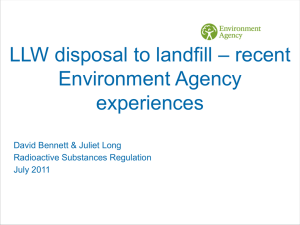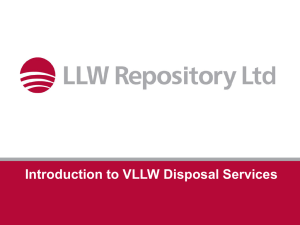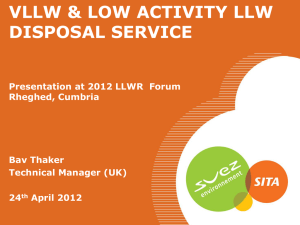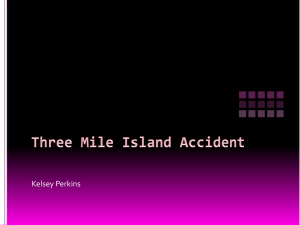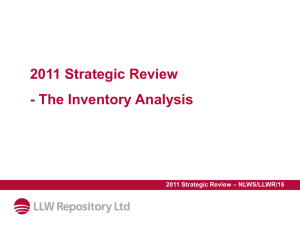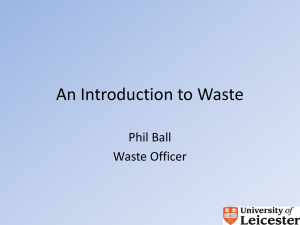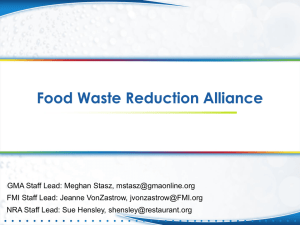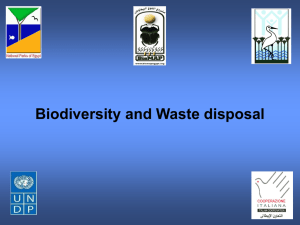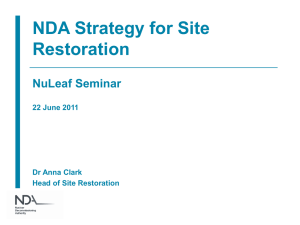UK Strategy for the Management of Solid Radioactive
advertisement
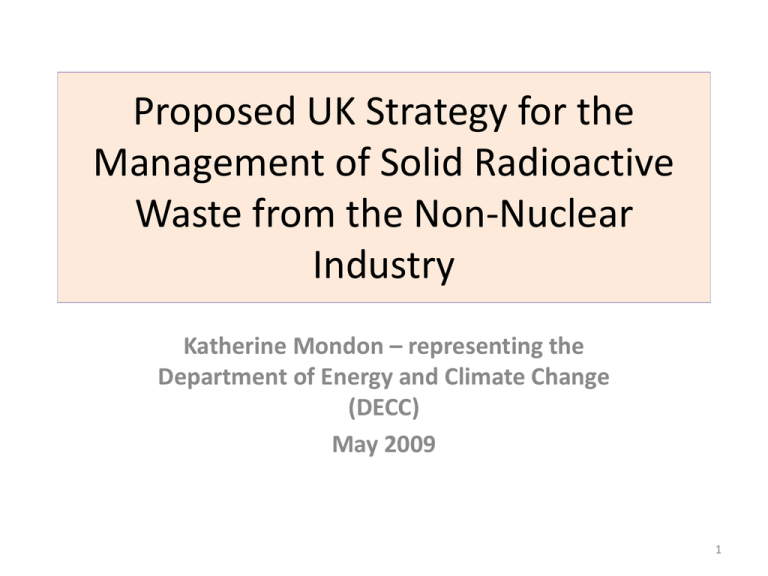
Proposed UK Strategy for the Management of Solid Radioactive Waste from the Non-Nuclear Industry Katherine Mondon – representing the Department of Energy and Climate Change (DECC) May 2009 1 Presentation will cover: •Definition of the non-nuclear industry •Description and quantity of the wastes •Disposal options for the wastes and associated risks •Why a UK strategy is needed for these sectors •Who the strategy is aimed at; what does it comprise •Sustainability appraisal •Conclusions and next steps 2 The Non-Nuclear Industry 1) Organisations that handle radioactivity for specific purposes, and consequently produce radioactive waste, eg hospitals – located around the UK 2) Industries that create radioactive waste as a result of their operations ie oil and gas industries hence mainly located in Scotland/North Sea. All are registered and/or authorised under the Radioactive Substances Act 1993 3 Non-Nuclear Industry Radioactive Waste Examples: •plastics, paper, glass, metal, soil •oil and gas industries – sludges and scales Majority of non-nuclear industry radioactive waste is Very Low Level Radioactive Waste (VLLW) and Low Level Radioactive Waste (LLW) 4 Quantities of Non-Nuclear Industry Radioactive Waste •Routine data collection: LLW only and in terms of radioactivity •Data on physical quantities from surveys: cover no more than about one third of industries holding RSA93 authorisations. •Data for VLLW highly uncertain. Estimates from surveys in 2005/6: UK arisings of VLLW plus LLW - around 5,400 m3 per year, Plus incinerator residues (VLLW) at 42,000 m3/year. 5 2008 survey covered 20% of 877 RSA93 authorisation holders Total VLLW and LLW for England/Wales: unlikely to exceed 50,000 m3/year Total quantity of M, C, I wastes across England: 272 million m3 /year Therefore non-nuclear wastes unlikely to exceed 0.02% of volumes of M,C,I wastes 6 Disposal options for non-nuclear industry wastes •Incineration (dominates disposal of primary VLLW and LLW) •Landfill (includes secondary VLLW as incinerator residues) •Some LLW must go to Low Level Waste Repository near Drigg Waste producers: must have RSA93 authorisations from the Environment Agency to dispose of waste. Disposal facilities taking low volume VLLW: no requirement for RSA93 licence Facilities taking LLW and high volume VLLW: must have RSA93 licence 7 Risks from non-nuclear industry radioactive waste disposals Health Protection Agency has contributed to the strategy document. Strategy includes a summary table of maximum radiation doses: •to workers from proximity to, and handling wastes •to the public from living near to disposal facilities All calculated doses are less than 20 microsieverts per year, which equates to a risk of dying of a cancer of one in a million 8 Disposal of solid LLW and VLLW, and potential exposure scenarios Direct exposure and inhalation air Discharges to air Dust from day to day operations Contamination in air deposited on land Exposure from direct irradiation from surface of land Ingestion of crops/animals Ash and air pollution control residues (VLLW) To landfill Reuse/recycling Combustible LLW/VLLW to incinerators Exposure due to reuse/recycling of incinerator residues Ingestion of drinking water Non combustible LLW/VLLW to landfill 9 Why does the non-nuclear industry need a waste strategy? 1. Industry has reported growing trend for fewer disposal facilities 2. Network of facilities for LLW is fragile – eg most RSA93 licensed incinerators operated by one company 3. The small volumes will not stimulate disposal market 4. Radioactive waste may deter waste facility operators 5. The diverse nature of the non-nuclear industry makes it difficult for it to act collectively – but the industry is vital to society 10 Hence, Government made a commitment via its 2007 LLW policy statement to prepare a non-nuclear industry waste strategy Summer 2007: Programme board set up to prepare strategy Membership: • NDA • Regional Technical Advisory Bodies (West Midlands and Yorkshire and Humberside) • Environmental Regulators • Waste producers • Government departments and devolved administrations 11 Proposed strategy is aimed at: •Non-nuclear industry waste producers •Environmental regulators •Waste planning bodies •NDA and its site licensed companies Also relevant to: •Members of the public •Those operating conventional waste facilities. 12 Information in strategy document covers : •Descriptions of the non-nuclear industry •Principles of radiation protection •Regulation, definitions of waste categories and disposal options •Summary of 2008 survey of waste producers •The assessment of risk from disposal from the nonnuclear industry Strategy then sets out the roles of different organisations in helping to maintain disposal network 13 Proposed roles of the waste producers/regulators (i) •Regarding RSA93 authorisations: - Further application of the waste hierarchy - For LLW disposals, explicit consideration of the principles of proximity and waste transport. •Regulators also have an educational role: - Assisting waste producers understand their authorisations - Assisting waste disposal facility operators’ understanding of the nature of LLW and VLLW and their regulation 14 Proposed role of the regulators (ii) •EA databases on radioactive waste from the non-nuclear industry: Can these be amended to include physical quantities on a routine basis? •Strategy urges regulators to ensure that they have the right contacts within local authorities for RSA93 consultations •Environmental permitting for conventional waste facilities: description of waste on permits should not exclude low volume VLLW 15 Proposed coverage of non-nuclear industry waste within land use planning •Planning Policy Statement 10: WPAs should address and plan for ALL relevant waste streams, including LLW •Strategy sets out national waste management requirement for radioactive waste, which should be taken into account by WPAs •Responsibilities of waste planning authorities vs environmental regulators are legally separate but inter-connected in practice •Guidance is given to waste planning authorities on their responsibilities within the strategy 16 Proposed roles of WPAs (i) Low volume VLLW: Only waste producers have to hold RSA93 authorisations But WPAs should be aware that any disposal facility taking conventional waste may also be taking low volume VLLW 17 Proposed role of WPAs (ii) High volume VLLW and LLW: Waste producers require RSA93 authorisations and disposal facilities must have RSA93 licences. •WPAs should be aware that existing and new disposal sites for conventional waste may apply to take LLW or high volume VLLW •WPAs should make note in their Local Development Frameworks that disposal requirements for such wastes may arise from time to time •Expectation is that the planning framework will be supportive of non-nuclear industry waste disposal needs 18 Connection between the non-nuclear industry waste strategy and the NDA LLW nuclear strategy NDA strategy may stimulate the supply of disposal facilities But strategy sets out NDA disposal routes and which situations are expected to benefit the non-nuclear industry: 1) LLWR near Drigg and its successor 2) New sites that the NDA’s SLCs may develop for: •controlled burial of nuclear LLW •landfill for nuclear high volume VLLW •new RSA93 licensed incinerators •new facilities for decontamination/recycling of waste 19 Sustainability appraisal – current position •Discussion of the role of individual disposal sites not covered in proposed strategy – non-nuclear industry will nearly always rely on facilities primarily intended for other large volume wastes • Annual risks from disposals of less than one in a million Hence Board decided that requirements of SEA Directive did not apply to the strategy But scoping report for Sustainability Appraisal undertaken – consultation in Jan/Feb 09. Table cross-references key issues identified in the scoping report on SA to aspects in the waste strategy. 20 CONCLUSIONS •Proposed strategy provides information on wastes, and guidance on roles of various bodies to maintain disposal network •Landfill and incineration are fit-for-purpose for most of the waste •Non-nuclear industry is scattered around the UK and their disposals should be undertaken with due consideration of proximity and waste transport •The planning frameworks should be supportive of non-nuclear industry waste disposals that are in line with regulatory requirements. •Next steps – oil and gas still to be covered (consultation in autumn 09?) 21
